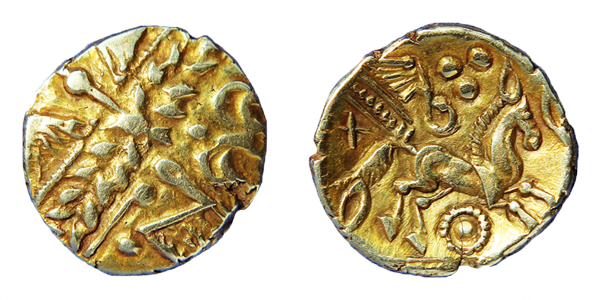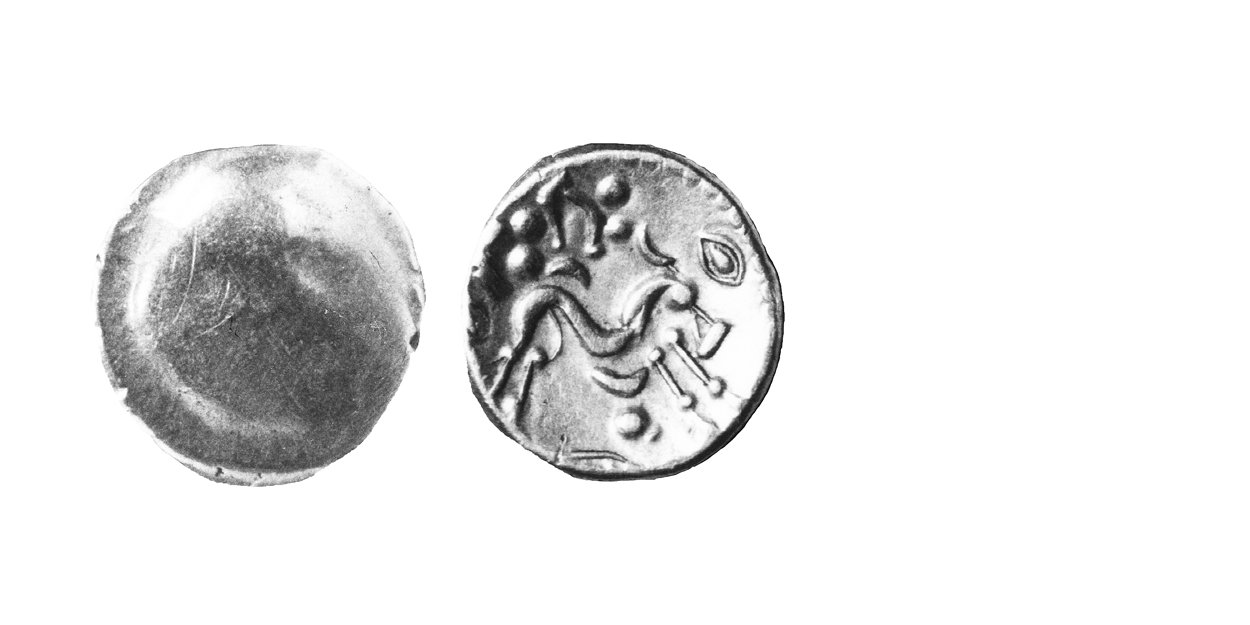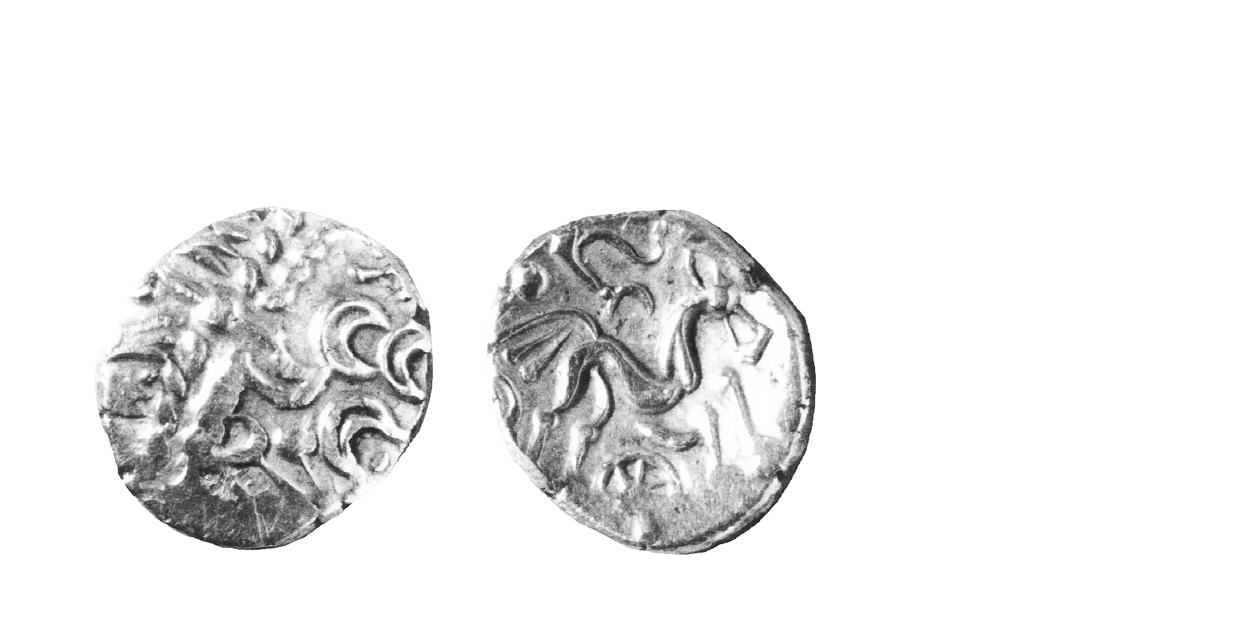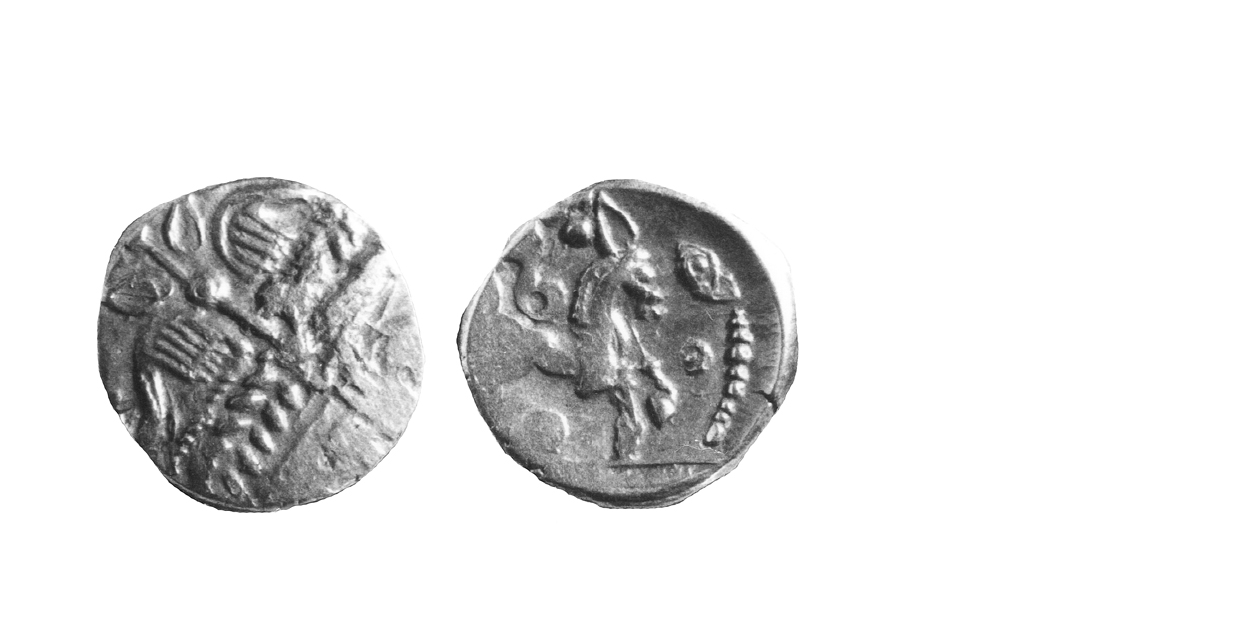
History
Caesarean Invasions (Info)
Coinage During Caesar's Invasions 55—54 BC.
Although the Gallic War Type stater had a relatively stable value compared to the Durotrigan coinage, it too suffered a decline. Its weight was lowered during the years following 60 B.C. in several stages from 6.35 to 5.80 grammes (42). Increasingly lower-value staters flooded Britain and the reduction eventually influenced local coinages. The heavier-weight Westerham (North) and Westerham (South), Clacton and Waldingfield issues of the Atrebates/Regni/Belgae and Trinovantes/Catuvellauni were driven out of circulation and the tribes stopped striking them. By the midpoint of the war, the requirement for coinage was largely met by imports.
Although imports of Gallic War staters increased to an unprecedented level (43), the trading networks in Britain demanded even greater quantities. Those of the Atrebates/Regni/Belgae and Trinovantes/Catuvellauni became longer as goods and manpower were sought well into the interior. After 55 B.C., the Atrebates/Regni/Belgae began to strike the lighter-weight Atrebatic Abstract Type in great quantity to feed a trading network extending as far away as the territories of the Dobunni and Corieltauvi. About the same time, the Trinovantes/Catuvellauni began to produce their own light-weight version, the Whaddon Chase Type.
At first, the Gallic War Type did not influence the outlying tribes because few of these coins reached them. Eventually, however, the weight reduction and quantity of light-weight coins became too great to ignore and the Iceni and Corieltauvi were forced to react (44). The Iceni debased the metallic content of their staters, gradually increasing the proportion of silver to gold until the coins were little more than white gold. The Corieltauvi, however, held out and refused to debase their staters. Eventually, a very small reduction was made to the North East Coast Type, possibly signaled by changing the direction of the horse on the reverse (133).
The period 57-56 B.C. proved to be a turning point in British history. Caesar invaded the Armorican peninsula, eliminated Gallic resistance there and destroyed the Venetic fleet. The disruptions are chronicled in the vast hoards of Armorican coins found in the Channel Islands. Though the deposition date of the hoards is somewhat controversial and may extend into the 30's B.C., it is clear the events of 56 initiated the turmoil (45). Debased silver staters, intended to finance the Armorican resistance, found their way to Guernsey and Jersey to be deposited, unused by refugees after the Armorican resistance collapsed.
As traumatic as events may have been in Armorica, the repercussions in Britain were equally severe. The Durotriges were now largely cut off from the Continent, and although there is some evidence for continuing trade, it is evident they lost many of their contacts in Gaul. They became increasingly isolated from the mainstream of British tribal development, to become a conservative and less-prosperous enclave, amid an increasingly prosperous Britain later in the century.
The following year, 55 B.C., Caesar made a brief reconnaissance foray into Kent. Nearly meeting with disaster, he returned to Gaul to plan a more elaborate invasion the following year. In 54 B.C., he mounted a second expedition, one that would change the tribal relationships in Britain. Crossing the Channel with a large force, he quickly overran Kent and pressed on to the Thames near the future site of London. Several British tribes sent envoys to offer submission, while others decided to continue the resistance. One of the defending tribes, led by a man named Cassivellaunus, had been harassing the Trinovantes/Catuvellauni earlier and Caesar set out to attack its oppidum. Cassivellaunus arranged a counterattack on Caesar's camp in Kent but this failed, thus breaking the main British resistance. After the failure in Kent, Cassivellaunus and the rest of the British tribes capitulated, ending the hostilities.
Traditionally, it has been stated that Cassivellaunus was ruler of the Catuvellauni, but no historic documentation supports this idea and Caesar never mentioned the name of the tribe. The "Cas" of Cassivellaunus and "Cat" of Catuvellauni were merely coincidental and did not indicate a connection. An elaborate North Thames history has been written around the conflict between the Catuvellauni and Trinovantes (46). This included a give-and-take power struggle between the two tribes that ultimately ensnared Rome in British tribal politics.
This old pseudo-history, written largely from the numismatic evidence, is now considered obsolete because numismatically the Catuvellauni and Trinovantes are indistinguishable (47). Although recent attempts to resurrect the old peudo-history have been made, these rely on the same over-interpretations of findspot data that marred the original studies of the 1940's. For the most part, the two tribes used a single coinage and appear as a single socio-economic unit. It is difficult to see them as adversaries and consequently the tribe-of-origin of Cassivellaunus is somewhat of a mystery. It may be he was merely a strong and charismatic figure from a relatively minor tribe or sub-group who rose to lead the opposition to Caesar's invasion only to sink back into obscurity after the threat passed.
The socio-economic results of the invasion, however, are quite plain: the Trinovantes/Catuvellauni directly benefited from Caesar's invasion. They had not resisted him and consequently were rewarded after the campaign, becoming the recipients of the cross-Channel wine trading rights, now controlled indirectly by the Romans on the Gallic side. The Cantii may have played an active part in the resistance by supplying the troops who, at Cassivellaunus's behest, attacked Caesar's camp. If so, they were probably barred from the cross-channel trade after the war.
The Gallic War had two important effects on British coinage. The first was the weight reduction in the British staters, marked by the introduction of new types (48). The effects of the weight reduction in the earlier period of the Gallic War has already been discussed, but towards the end of the war these effects became pronounced, reflected most dramatically in the coinage of the Trinovantes/Catuvellauni. The new Whaddon Chase Type stater appeared, based partially on the Continental Triple-Tailed Horse Type, but with design elements copied directly from Republican denarii (49).
The second effect was the introduction of silver coins, the designs of which were often inspired by Republican denarii (50). The Gallic tribes had been striking silver coins during the war and some may have continued to do so afterwards. The British tribes may have been prompted to strike silver because of the Gallic practice. Also the presence of Roman troops in Britain, and the face-to-face contact with Caesar during his visits possibly hastened the introduction of silver coin throughout the southeast. By the end of the Gallic War, the Atrebates/Regni/Belgae, Trinovantes/Catuvellauni, Iceni and Corieltauvi had all started striking silver coins to complement their gold issues.
At the very end of the Gallic War, one final event influenced the future of British coinage. After the defeat of the united Gallic tribes at Alesia in 51 B.C., the leader of the Continental Atrebates, Commius, fled to Britain to join his tribal cousins. Previously an ally of Caesar, he became disillusioned and joined Vercingetorix's heroic but doomed attempt to repulse the Romans. Commius, declaring he never wanted to see the face of another Roman, climbed into his ship to leave for Britain and found himself beached by a low tide. Seeing the Romans in the distance, Commius raised his sails as if he were sailing away and tricked them into giving up the pursuit. Later, when the tide came in, he sailed to Britain where he spent the rest of his days. There, he modified the Atrebatic Abstract Type staters by adding his name to the reverse of the coin, thus launching the first of the British dynastic issues.
Next section: Last Uninscribed Coinages – Introduction



